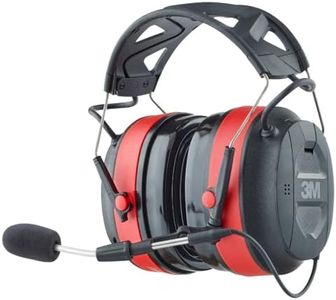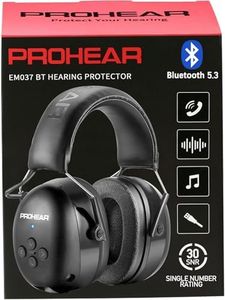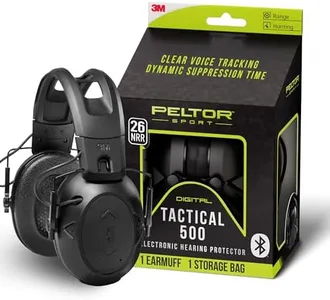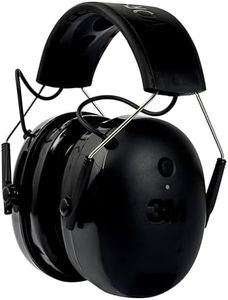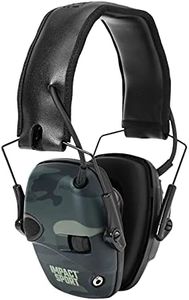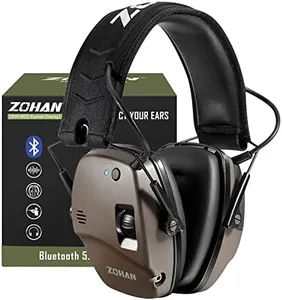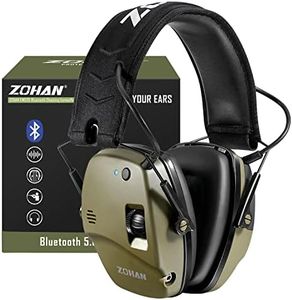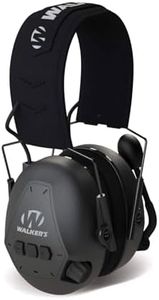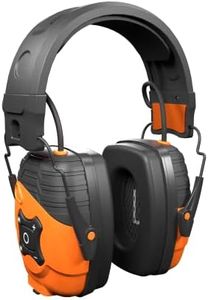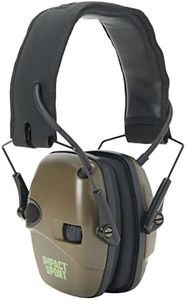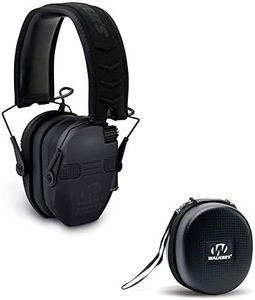We Use CookiesWe use cookies to enhance the security, performance,
functionality and for analytical and promotional activities. By continuing to browse this site you
are agreeing to our privacy policy
10 Best Bluetooth Shooting Ear Muffs
From leading brands and best sellers available on the web.Buying Guide for the Best Bluetooth Shooting Ear Muffs
When choosing Bluetooth shooting ear muffs, you're looking for a blend of hearing protection and wireless convenience. These ear muffs are designed not only to protect your ears from loud gunfire but also to let you listen to music, take phone calls, or receive range commands via Bluetooth. The best pair for you depends on where you'll use them, how much communication you need, and your comfort preferences. Understanding the key specs will help you find the right fit so you stay safe, comfortable, and connected while shooting.Noise Reduction Rating (NRR)Noise Reduction Rating, or NRR, tells you how much noise the ear muffs can block out. This is particularly important at shooting ranges where sounds can reach dangerous levels. NRR values are measured in decibels (dB), and typical shooting ear muffs range from about 21dB to 30dB or higher. Lower numbers mean less protection and might be suited for quieter shooting situations or shorter exposure. Mid-range NRR (around 24-27dB) offers a balance for both indoor and outdoor shooting. Higher NRR (28dB and up) is best if you shoot larger calibers, are indoors, or have sensitive hearing. Choose the NRR that matches the loudness of your environment and how long you'll be exposed to noise.
Bluetooth Version and FeaturesThe Bluetooth version and features determine how reliably and quickly your ear muffs connect to your devices, such as phones or radios. Newer Bluetooth versions (like 5.0 and above) offer better range, longer battery life, and more stable connections. Features like multipoint pairing allow you to connect to more than one device at once. Older Bluetooth versions can still work but may drop connection more easily or drain the battery faster. Think about how you’ll use Bluetooth — just for music, calls, or as part of a shooting team with communication needs — and pick accordingly.
Active vs. Passive ProtectionSome ear muffs only block sound passively (by physically covering your ears), while others have electronic 'active' features that amplify safe sounds (like conversation) and instantly block dangerous noise. Passive muffs are simple and reliable but you can’t hear low noises well once they're on. Active muffs are better for situational awareness and group shooting because you can still hear voices and range commands, but they are usually more expensive and require batteries. If you shoot socially or want to stay aware of your surroundings, go active; if you're solo and prefer simplicity, passive might do.
Battery Life and ChargingBluetooth shooting ear muffs rely on power for both the Bluetooth and any electronic hearing protection features. Battery life tells you how long you can use the ear muffs before recharging or changing batteries. Basic models may last a day or two on a single charge, while premium versions can go much longer. Some use AA or AAA batteries, while others have built-in rechargeable batteries. If you shoot long sessions or dislike charging often, go for longer battery life or easily replaceable batteries. For occasional, short use, this may be less critical.
Fit and ComfortFit and comfort refer to how well the ear muffs feel on your head during wear. Look for adjustable headbands, padded ear cups, and a weight that feels manageable for long sessions. Poorly fitting muffs can cause ear fatigue, headaches, or let in harmful noise. Larger ear cups fit bigger ears but might feel bulky, while more compact designs are lighter but could pinch. Consider how long you’ll wear them at a stretch and if you wear glasses (as this can affect the seal), then pick a fit that matches your activity and personal comfort.
Durability and Build QualityDurability and build quality mean how well the ear muffs can withstand regular use, exposure to the elements, and the rough conditions often found at ranges. Strong materials (like reinforced plastics and metal bands) tend to last longer and protect internal electronics better. Some may have dust and moisture resistance. If you shoot often or in harsh conditions, prioritize tough, well-built muffs; if you shoot occasionally in mild environments, basic build quality may suffice.
Controls and Ease of UseControls and ease of use describe how simple it is to adjust volume, answer calls, or pair devices while wearing the ear muffs. Larger, easy-to-find buttons and intuitive layouts are important, especially if you’ll adjust settings while wearing gloves or during shooting. Some models have voice prompts or indicator lights to help you know what's on or connected. If you want stress-free operation while focusing on shooting, choose ear muffs with controls that suit your needs.
